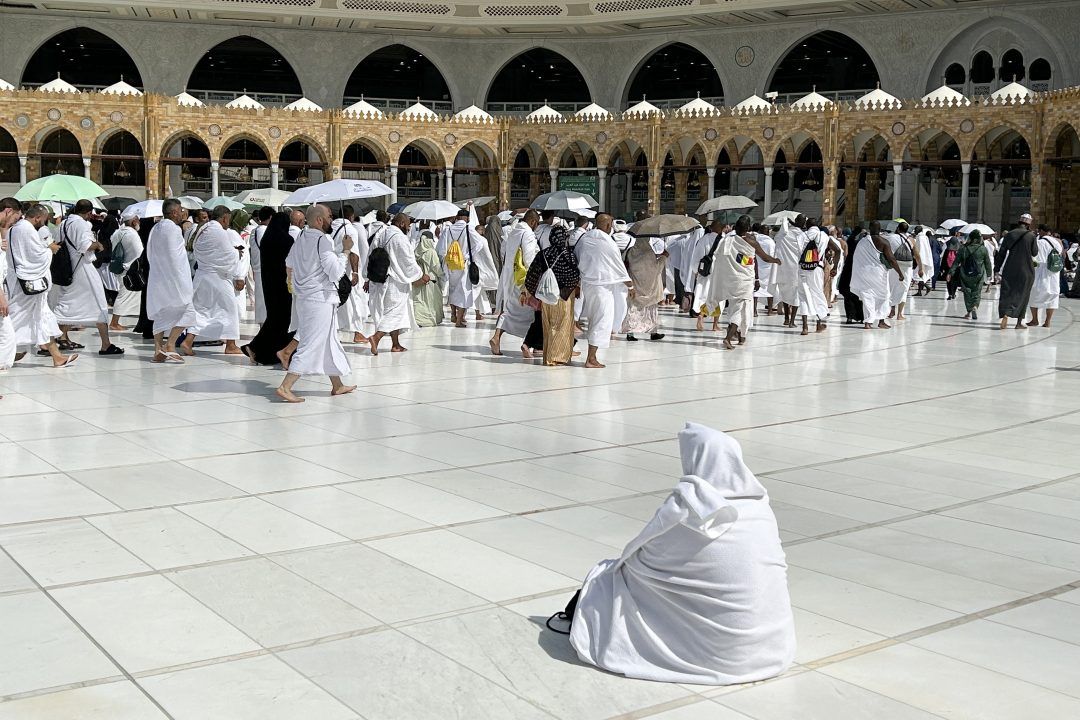- Home
- Middle East
- A Hotter Hajj as Climate Change May Outpace Mitigation Efforts

©FADEL SENNA / AFP
From misting systems to heat-reflective road coverings, Saudi officials are trying to aid hajj pilgrims in coping with heat, but scientists caution that climate change may outpace these efforts.
The annual pilgrimage, one of the world's largest religious gatherings, coincides again this year with the hot Saudi summer, with officials predicting average highs of 44 degrees Celsius (111 Fahrenheit).
Heat mitigation measures implemented at the holy sites in recent years may also have something to do with it.
Near the Kaaba, the black cubic structure in the Grand Mosque towards which all Muslims pray, new air-conditioned spaces allow pilgrims to cool off, and a climate-controlled pathway now connects the hills of Safa and Marwa inside the mosque compound.
Since last year, roads used by the faithful have been covered in a white cooling material that Saudi officials say reduces the temperature of the asphalt by 20 percent.
On top of that, volunteers distribute water and umbrellas, while misting systems and air-conditioned shopping malls provide temporary relief between prayers.
Yet officials have few options to alleviate certain stages of the hajj, notably Saturday's day-long prayers under the blazing sun on Mount Arafat.
Last year more than 10,000 cases of heat-related illnesses were documented, 10 percent of which were heat stroke, said health ministry spokesperson, Mohammad Abdulali.
Saudi Arabia has not provided figures on hajj fatalities last year, though at least 240 people -- many from Indonesia -- died during the pilgrimage, according to figures announced by various countries which did not specify causes of death.
Abdulali said there were at least some deaths connected to heat stress in 2023 "but their number was limited" because of rapid interventions taken by medical teams and their experience "acquired over decades".
The timing of the hajj is determined by the Islamic lunar calendar, and years in which it takes place during summer have long brought high numbers of heat stress cases, according to a study published last month by the King Faisal Specialist Hospital and Research Center based in Riyadh.
In 1987, for example, about 1,000 pilgrims died from heat-related conditions, the study says.
But in the past 40 years, thanks to "mitigation measures", incidents of heat stress have fallen by 74.6 percent and the mortality rate from these cases has fallen by 47.6 percent, it says.
The same study notes, however, that temperatures in the region are rising by 0.4 degrees Celsius per decade.
"Worsening heat may be outpacing the comprehensive mitigation strategies in place," it says.
Distributing water and installing misting systems "will not be enough" to adapt, said Fahad Saeed of Climate Analytics, an institute based in Germany.
If conditions worsen, he said, there is a risk that "we are going to lose some of the rituals" seen as essential to the pilgrimage.
Sahar Al Attar, with AFP
The annual pilgrimage, one of the world's largest religious gatherings, coincides again this year with the hot Saudi summer, with officials predicting average highs of 44 degrees Celsius (111 Fahrenheit).
Heat mitigation measures implemented at the holy sites in recent years may also have something to do with it.
Near the Kaaba, the black cubic structure in the Grand Mosque towards which all Muslims pray, new air-conditioned spaces allow pilgrims to cool off, and a climate-controlled pathway now connects the hills of Safa and Marwa inside the mosque compound.
Since last year, roads used by the faithful have been covered in a white cooling material that Saudi officials say reduces the temperature of the asphalt by 20 percent.
On top of that, volunteers distribute water and umbrellas, while misting systems and air-conditioned shopping malls provide temporary relief between prayers.
Heat-related illnesses
Yet officials have few options to alleviate certain stages of the hajj, notably Saturday's day-long prayers under the blazing sun on Mount Arafat.
Last year more than 10,000 cases of heat-related illnesses were documented, 10 percent of which were heat stroke, said health ministry spokesperson, Mohammad Abdulali.
Saudi Arabia has not provided figures on hajj fatalities last year, though at least 240 people -- many from Indonesia -- died during the pilgrimage, according to figures announced by various countries which did not specify causes of death.
Abdulali said there were at least some deaths connected to heat stress in 2023 "but their number was limited" because of rapid interventions taken by medical teams and their experience "acquired over decades".
The timing of the hajj is determined by the Islamic lunar calendar, and years in which it takes place during summer have long brought high numbers of heat stress cases, according to a study published last month by the King Faisal Specialist Hospital and Research Center based in Riyadh.
In 1987, for example, about 1,000 pilgrims died from heat-related conditions, the study says.
But in the past 40 years, thanks to "mitigation measures", incidents of heat stress have fallen by 74.6 percent and the mortality rate from these cases has fallen by 47.6 percent, it says.
Water sprays 'not enough'
The same study notes, however, that temperatures in the region are rising by 0.4 degrees Celsius per decade.
"Worsening heat may be outpacing the comprehensive mitigation strategies in place," it says.
Distributing water and installing misting systems "will not be enough" to adapt, said Fahad Saeed of Climate Analytics, an institute based in Germany.
If conditions worsen, he said, there is a risk that "we are going to lose some of the rituals" seen as essential to the pilgrimage.
Sahar Al Attar, with AFP
Read more




Comments